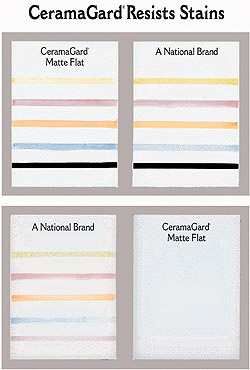 These photos demonstrate the stainblocking power of CeramaGard, a ceramic paint made by Coronado Paints. The top photo shows CeramaGard and another leading brand of interior paint on a clear Plexiglas panel. Both finishes are stained with marking pens. The bottom images are of the reverse side of the same panels, illustrating how stains do not penetrate the coatings. Instead, they remain harmlessly on the surface and can be easily removed with a mild household clearner. These photos demonstrate the stainblocking power of CeramaGard, a ceramic paint made by Coronado Paints. The top photo shows CeramaGard and another leading brand of interior paint on a clear Plexiglas panel. Both finishes are stained with marking pens. The bottom images are of the reverse side of the same panels, illustrating how stains do not penetrate the coatings. Instead, they remain harmlessly on the surface and can be easily removed with a mild household clearner. |
...continued from previous page
Ceramic Paints and
Ceramic Pigments
While some manufacturers tout the virtues of ceramic pigments, others are more skeptical. But all agree that it's the total formulation that creates a great paint.
by Stacey Enesey Klemenc
The superior qualities listed above are not just characteristic of ceramic-laden paints.
The Sherwin-Williams Co., for example, recently introduced its Duration Home, a high-quality interior latex paint enhanced with acrylic polymers touted to be highly stain resistant and extremely washable. The secret to its durability and performance, reveals Steve Revnew, director of marketing, is a patent-pending cross-linking technology.
“A chemical reaction occurs within the resin to form a tougher, nonporous paint film when compared to conventional-type coatings,” he explains. When dry, the film is so tough that virtually everything from ketchup and mustard to markers and red wine can be easily wiped off with water or, if necessary, a mild household cleaner, leaving the painted surface stain-free and intact. “There’s no paint on our rags,” he adds, and no unsightly burnish marks on the cleaned wall.
“Just because a product contains ceramic doesn’t mean it’s washable,” Revnew says. “It’s an additive much like any other.” Rather than focusing on just one ingredient, “We look at the total formulation to ensure that it delivers what the consumer is looking for and that it meets the professional applicator’s needs,” which includes good hiding and good touch-up.
While he agrees that ceramic pigments are very hard, Revnew says that a ceramic-laden paint film is still permeable in the space in between the spheres. Unlike walls painted with Duration Home, “They are not covered by an entire chemically cured coating.”
Bob Golownia, technical manager of exterior waterborne coatings for ICI Paints, says he thinks it’s possible to formulate good quality paints with or without ceramic pigments. “My view is that the ceramic pigments available today don’t offer an attractive balance of cost and performance when formulated into an architectural paint,” he says. “The amount you have to add to get a noticeable improvement in quality costs too much. If you use the less expensive ceramic pigments, they tend to be off color.”
Golownia, who deals exclusively with exterior paint, says his company’s newest line, This Old House Paint, features a network of urethane polymers that enhance the paint’s application abilities and finished appearance. He says that most companies that manufacture ceramic paint focus on interior products where you need paint that is tough and abrasion resistant.
“For exterior paint, scrubbability and abrasion resistance are of secondary importance. You care mostly about how the coating will resist the effects of the weather and the buildup of dirt, mildew and algae. Ceramic pigment doesn’t enhance performance where those sorts of properties are concerned,” Golownia says.
Patel counters that companies that aren’t making ceramic paints simply don’t want to spend the money where manufacturing is concerned. He concedes that ceramic is a very expensive pigment — probably 10 to 15 times more expensive than traditional pigment. Muralo makes up for this added expense, he continues, by not embarking on expensive advertising campaigns and relying more on their reputation and word of mouth.
Explaining that the company invests a high percentage of sales into research, he emphasizes, “We don’t cut corners when it comes to making paint. We design a product based on technology that solves today’s problems and then worry about marketing it.”
Patel also adds that Graham has had an exterior ceramic paint on the market for seven to eight years. He says it is not only extremely durable but also resists UV rays, holds color better and doesn’t chalk like some conventional paints.
Spillane says Benjamin Moore has investigated the possibility of using ceramic in exterior paints but so far hasn’t discovered any advantages.
For years, the paint industry has tried to use alternative ingredients to improve the performance of paint, including such additives as Teflon and mica. “We’re constantly trying to find raw materials that will offer different properties to a product,” Spillane says.
“I don’t think ceramic technology is the main difference in quality products. The true durability lies in the combination of the resin and the pigment.
“We were successful with ceramic. What’s next? What’s harder than ceramic? How about diamonds? Maybe we can suspend diamond dust in a resin,” Spillane muses. “Can we build a better product without ceramic? That’s the question we’ll answer someday.”

|

